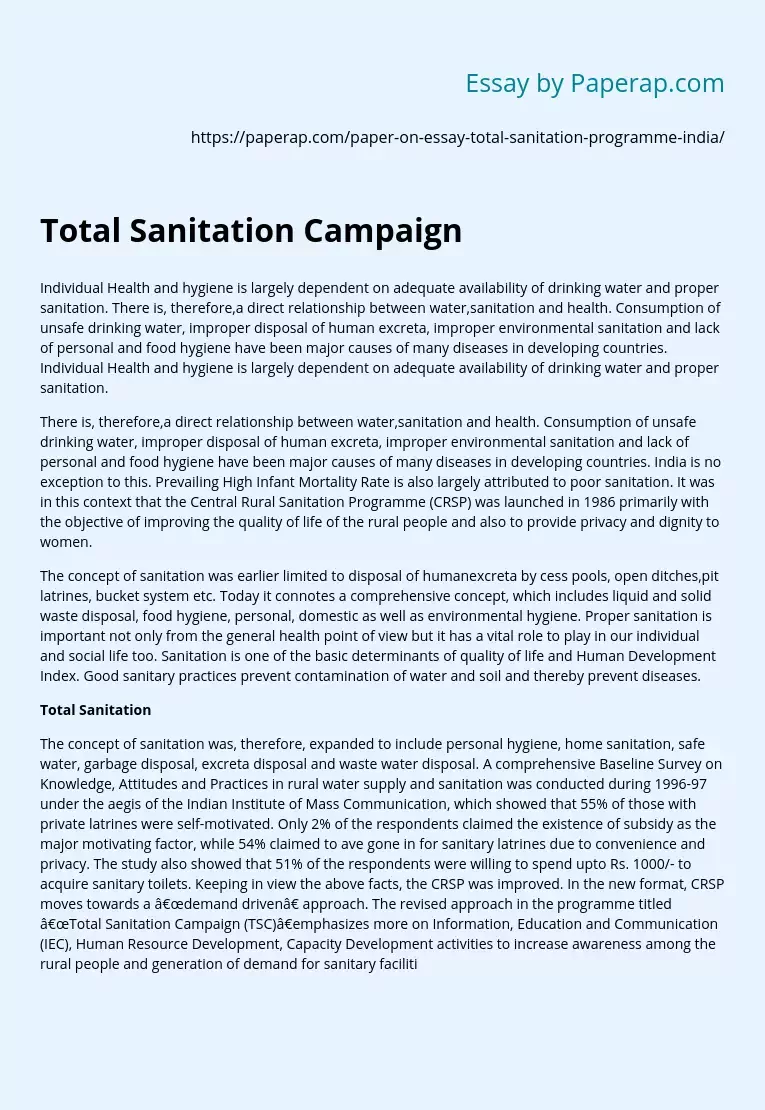Total Sanitation Campaign
Individual Health and hygiene is largely dependent on adequate availability of drinking water and proper sanitation. There is, therefore,a direct relationship between water,sanitation and health.
Consumption of unsafe drinking water, improper disposal of human excreta, improper environmental sanitation and lack of personal and food hygiene have been major causes of many diseases in developing countries. Individual Health and hygiene is largely dependent on adequate availability of drinking water and proper sanitation.
There is, therefore,a direct relationship between water,sanitation and health. Consumption of unsafe drinking water, improper disposal of human excreta, improper environmental sanitation and lack of personal and food hygiene have been major causes of many diseases in developing countries. India is no exception to this. Prevailing High Infant Mortality Rate is also largely attributed to poor sanitation. It was in this context that the Central Rural Sanitation Programme (CRSP) was launched in 1986 primarily with the objective of improving the quality of life of the rural people and also to provide privacy and dignity to women.
The concept of sanitation was earlier limited to disposal of humanexcreta by cess pools, open ditches,pit latrines, bucket system etc. Today it connotes a comprehensive concept, which includes liquid and solid waste disposal, food hygiene, personal, domestic as well as environmental hygiene. Proper sanitation is important not only from the general health point of view but it has a vital role to play in our individual and social life too. Sanitation is one of the basic determinants of quality of life and Human Development Index.
Good sanitary practices prevent contamination of water and soil and thereby prevent diseases.
The concept of sanitation was, therefore, expanded to include personal hygiene, home sanitation, safe water, garbage disposal, excreta disposal and waste water disposal. A comprehensive Baseline Survey on Knowledge, Attitudes and Practices in rural water supply and sanitation was conducted during 1996-97 under the aegis of the Indian Institute of Mass Communication, which showed that 55% of those with private latrines were self-motivated. Only 2% of the respondents claimed the existence of subsidy as the major motivating factor, while 54% claimed to ave gone in for sanitary latrines due to convenience and privacy. The study also showed that 51% of the respondents were willing to spend upto Rs. 1000/- to acquire sanitary toilets. Keeping in view the above facts, the CRSP was improved. In the new format, CRSP moves towards a “demand driven” approach. The revised approach in the programme titled “Total Sanitation Campaign (TSC)”emphasizes more on Information, Education and Communication (IEC), Human Resource Development, Capacity Development activities to increase awareness among the rural people and generation of demand for sanitary facilities.
This will also enhance people’s capacity to choose appropriate options through alternate delivery mechanisms as per their economic condition. The Programme is being implemented with focus on community-led and people centered initiatives. Children play an effective role in absorbing and popularising new q+`ideas and concepts. This Programme, therefore, intends to tap their potential as the most persuasive advocates of good sanitation practices in their own households and in schools.
Total Sanitation Campaign. (2019, Dec 05). Retrieved from https://paperap.com/paper-on-essay-total-sanitation-programme-india/

